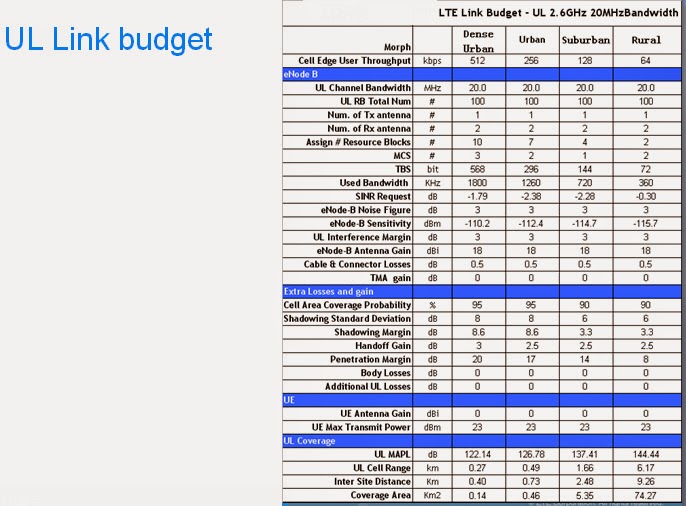Content
FDD-LTE UL Link budget
FDD-LTE DL Link Budget
Cell radius and areas
FDD-LTE link budget overview
The process of FDD-LTE
network planning
Link budget input and
output
Normal Link budget
requirements
Link budget model
Shannon formula
UL Link budget process
UL link budget
Methodology
Assigned RB number
Number of Resource
Blocks
Modulation & Coding
Scheme
This determines the Modulation Order which in
turn determines the TBS Index.
TBS and MCS
Assign RB number
SINR
- SINR Target depends on:
- eNode-B equipment performance
- Radio conditions (multipath fading profile, mobile speed)
- Receive diversity (2-way by default or optional 4-way)
- Targeted data rate and quality of service
- The Modulation and Coding Scheme
- Max allowed number of HARQ transmissions (Maximum of 4 on UL)
- HARQ BLER target (10% considered by default)
- Derived from link level simulations or better by equipment measurements (lab or on-field measurements)
Assign RB number
Rx receive sensitivity
Thermal Noise
Receiver sensitivity
UL Interference Margin
UL Interference Margin
Four Antenna
configuration way
TMA gain
Shadowing Margin
Hard handover Gain
Penetration loss
Body loss
Propagation model
Different of UL and DL
link budget
DL link budget
Methodology
DL Link budget character
DL link budget approach
- Base on the UL link budget result decide the cell range.
- Base on the decided cell range, get DL path loss at cell edge
- Base on DL path loss and considered DL Tx power and total other gain & loss to get DL signal power at cell edge.
- According Geometry factor at cell edge to get other cell interference
- Base on DL signal power and other cell interference and noise to get DL SINR at cell edge.
- Base on DL SINR at cell edge and the DL bandwidth and available RB number to decide the MCS and TBS, and then, get the DL throughput at cell edge.
DL shadowing Margin
Adjacent Tx
Power load
Geometry factor
SINR
DL Link budget
DL Link budget approach
Limited link
Cell range and inter
site distance
Glossary
- RB: Resource Block
- TBS: Transport Block Size
- MCS: Modulation & Coding Scheme
- SINR: Signal to Interference plus Noise Ratio
- MIMO: Multiple Input Multiple Output
- MAPL: Maximum Allowable Path Loss
- TMA: Tower Amplifier
- BLER: Block Error Ratio
- HARQ: Hybrid automatic repeat request
- SNR: Signal to Noise Ratio
- NF: Noise Figure
- ISD: Inter-station Distance
- CDF: Cumulated Distribution Function
- TTI: Transmission Time Interval
End of Course






























































